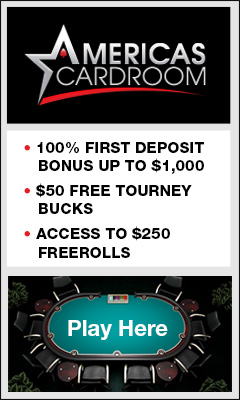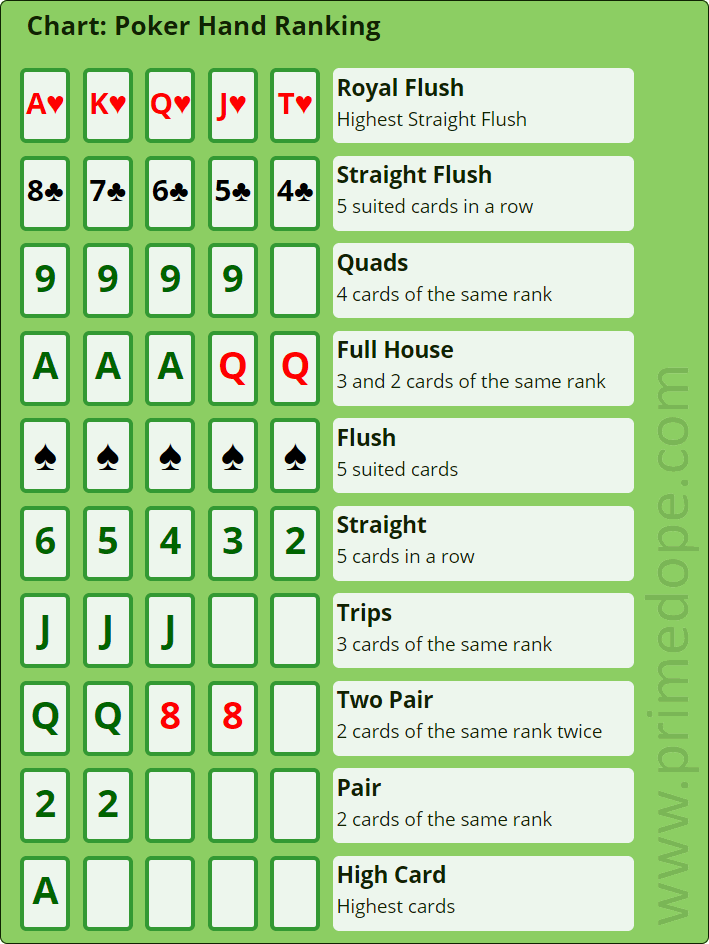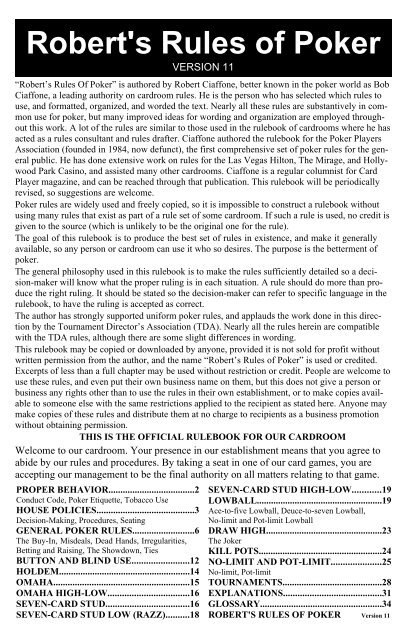Official Poker Tournament Rules
- Official Poker Tournament Rules 2019
- Official Poker Tournament Rules Poker
- Wsop Poker Tournament Rules
- Video Poker Tournament Rules
Buy-In

Buy-in is the dues (usually cash) every player pays to play at a poker tournament . These dues are put in a prize pool to pay the tournament winner(s).
Typical amount of buy in range from $5/player (small house games) to $10,000/player (world series of poker main event). Sometimes the buy-in is in the form of $50+$5. This means that every player will have to pay $55 to get in the game. However only $50 of it goes toward the prize pool and $5 goes to the “house”. The $5 fee is usually to pay for the host’s costs and profit.
If you are hosting a poker tournament you need to specify the amount of the buy in before the game. Use the following points to choose the best buy-in amount:
- How large (number of players) you want your tournament to be. A larger buy-in translates into fewer players. Therefore, if you want to host a large tournament (Ex. a charity poker tournament), you’ll be better off with a smaller buy-in.
- The amount you and other poker players at the game are willing to lose.
- If you are offering dedicated dealers at every table, free food, or for your own profit, you can add a 10% fee to the buy-in amount.
Advice on Buy-In:
Royal Hold’em is a unique poker game using only the aces, tens and court cards and is a rarely found on other online sites. Thousands of poker tournaments run each week. A table is ready right now! Tournament play follows standard poker Tournament rules on all Replay Poker.

Note that there are multiple stages in a poker tournament, including the beginning stage, the middle stage, the bubble stage, in the money, the final table, and the heads-up encounter. As you advance through the stages, you'll be able to put your poker playing skills to the test against increasingly tough competition. Rule: Number of Players at Final Table 10-handed events seat 10, 9-handed and 8-handed events seat 9 and 7-handed and 6-handed events seat 7 at the final table. No final table should seat more than 10. This rule does not apply to heads-up events. Every poker tournament series, event and festival in the US and Canada is here on PokerAtlas, including the World Series of Poker (WSOP), World Poker Tour (WPT), Heartland Poker Tour (HPT), and all others. All-in Poker Rules: Rule #1 – Table Stakes – The table stakes rule says that a player can’t be forced to wager more than he has brought to the table. In the past, it may have been possible for richer players to bully poorer players by betting amounts so large that no-one would be able to call, even if they wanted to.
Following are some Buy-In advice and notes to help you run a smooth and organized poker tournament:
- If you are playing for a large amount, it’s better to set longer blind periods such as half an hour. When players pay a considerable amount of money, they want to at least stay in the game for a while. Long blind period stretches the length of the game.
- Players play tighter when the buy-in amount is large. So if you are hosting an expensive tournament with 3 tables or so expect a long tournament (at least 5 or 6 hours).
- As a rule of thumb take cash only for the buy-in money. There will always be players that “forgot” to bring cash with them or want to play on a loan. Keep in mind that YOU (the tournament host) are responsible to pay the winner at the end. So make everyone pay up front. You can simply tell players in question that you “don’t have enough cash at home to cover them”.
- Write down the name of all players and mark their names “Paid” once you take the buy-in money from them

Rebuys
Imagine you’re hosting a tournament with 15 players and your friend busts out early. He has to sit around and watch everyone play until a new game has started. This is where rebuys come in. The rebuy allows the player who just lost all of his chips to buy back in the tournament.
Imagine you’re hosting a tournament with 15 players and your friend busts out early. He has to sit around and watch everyone play until a new game has started. This is where rebuys come in. The rebuy allows the player who just lost all of his chips to buy back in the tournament.
- The rebuy amount should be the same amount as the original buy-in amount.
- Players who rebuy should get the same amount of chips as they received in the beginning of the game.

Advice on Rebuys
A rebuy tournament has it’s own rules and constraints. Following are the most important ones:
- The number of times that players can rebuy should be set before the game starts. It can be 1, 2, 3 or unlimited.
- Rebuys are only allowed in a limited amount of time in the beginning of the tournament. This time is usually set by the number of times that the tournament blind has increased. For example 2 rebuys per player can be allowed during the first 3 blinds.
- Rebuys can be allowed when a player loses all of his chips or the his chip count goes under a certain level. For example in a tournament where players start with 2500 in chips, rebuys can be allowed when a player’s chip count goes under $500. This rules has to be set prior to starting the tournament.
- • Players can only add enough chips to make their stack the original amount. In the above example if a player loses his chips down to 400, he can do a rebuy, but only receive 2100 in chips from the tournament manager.
- • If the player wants to rebuy when he still has chips (less than 500 in the above example) he will still have to pay the full amount for rebuy.
- If you do allow rebuys in your poker tournament, make sure you write down the name of players who rebuy with the number of time they have re-bought.
Once you decide to have rebuys at your tournament, you need to decide how many re-buys you want to allow per player. There are two different ways that you can handle this:
- Limited rebuy: A limited rebuy is when each player can rebuy only certain number of times. After rebuying that many times, he/she is out of tournament.
- Unlimited rebuy: In an unlimited rebuy tournament, players can rebuy (buy back) as many times as they want, until the rebuy period is over. A good tournament structure would be to allow unlimited re-buys during the first two/three blinds. Unlimited rebuy also creates larger prize pools.
Official Poker Tournament Rules 2019
A poker tournament that does not allow rebuys is called a freezout tournament.
Effects of rebuy on the game:
Official Poker Tournament Rules Poker
- Once rebuys are allowed in a tournament players know that they can buy back if they bust out so the game tends to be looser than normal. This varies by the amount of buy-in and rebuy, but in general you are going to have a looser game with rebuys than without rebuy.
- Rebuys tend to create large prize pools. Let’s say if you have a $10 buy in with unlimited re buys for the first hour with 16 players. Without the rebuy you will have $160 in the prize pool. With the rebuy your prize pool usually doubles or triples. The reason for that is $10 is not much and once people lose they want to get back in the game so they spent another $10 and mostly don’t keep track of how many times they’ve bought in.
Basic Strategy Tip
Wsop Poker Tournament Rules
If you are playing at an unlimited rebuy tournament, try to double and triple up fast, but don’t play too loose, and keep in mind if you are doing a rebuy for the fourth or fifth time, you probably should call it the night. After your fourth or fifth rebuy, other players stacks are going to be much larger than the original stack (which is what you would get if you rebuy). This makes it every hard (if not impossible) for you to catch up and be able to make plays if you are re-buying late in the tournament.
Misdeals
Video Poker Tournament Rules
- The following circumstances cause a misdeal, provided attention is called to the error before two players have acted on their hands. (If two players have acted in turn, the deal must be played to conclusion, as explained in rule #2)
- The first or second card of the hand has been dealt faceup or exposed through dealer error.
- Two or more cards have been exposed by the dealer.
- Two or more boxed cards (improperly faced cards) are found.
- Two or more extra cards have been dealt in the starting hands of a game.
- An incorrect number of cards has been dealt to a player, except the top card may be dealt if it goes to the player in proper sequence.
- Any card has been dealt out of the proper sequence (except an exposed card may be replaced by the burncard without such action causing a misdeal).
- The button was out of position.
- The first card was dealt to the wrong position.
- Cards have been dealt to an empty seat or a player not entitled to a hand.
- A player has been dealt out who is entitled to a hand. This player must be present at the table or have posted a blind or ante.
- Action is considered to occur in stud games when two players after the forced bet have acted on their hands. In button games, action is considered to occur when two players after the blinds have acted on their hands. Once action occurs, a misdeal can no longer be declared. The hand is played to conclusion and no money is returned to any player whose hand is fouled.